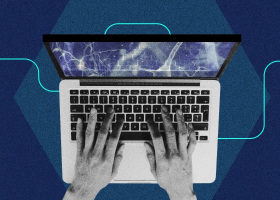Simplify Medical Writing Workflows in Life Sciences
Let’s jump in and learn:
- What Are Electronic Medical Records Systems?
- Challenges and Considerations Related to Electronics Medical Records Systems
- What Is the Most Used EMR System?
- The Benefits and Risks of Using EMRs/EHRs
- Risks from EMR Systems and EHR Systems
- Managing the Risks that Come with Electronic Medical Records Systems and Electronic Health Records Systems
- Why EMRs are Valuable to Cyber Attackers
- How are EMRs Stored and Handled?
- Medical Writing Workflows Using Electronic Medical Records Systems
What Are Electronic Medical Records Systems?
Electronic medical records (EMR) systems are solutions that store and manage digital versions of patients’ medical charts. With EMR systems, everything about an individual’s lifetime health history is collected and centrally stored, including data about patients’ medical history, medication, allergies, immunization status, laboratory test results, radiology images, vital signs, demographics, personal statistics like age and weight, and billing information. EMR systems are designed to aid in clinical decision-making by providing healthcare professionals with a comprehensive set of patient data.
Taking a technology-driven approach to patient record-keeping, EMR systems have transformed the healthcare industry by aggregating patient information and streamlining the documentation process. In addition, by providing a complete and consolidated view of patients’ medical and treatment history, the quality of patient care is materially improved.

Key Elements and Functions of Electronics Medical Records Systems
| EMR Systems for Healthcare Providers | EMR Systems for Patients |
| EMR systems offer healthcare providers a more efficient way to collect, store, and access patient information, leading to better decision-making and improved patient outcomes. They also streamline the billing process and reduce paperwork. | Patients benefit from improved coordination of care, reduced errors, and more efficient visits. EMR systems can also empower patients to take a more active role in their health by providing easier and more broad access to their medical records. |
Electronic medical records systems provide more than just a repository for digital versions of paper medical charts. They have several key components and capabilities that have made them a key part of modern healthcare practices, including the following.
Patient health information
At the core of EMR systems is patient health information, such as diagnostic information, treatment history, medications, lab test results, and patient demographics. Healthcare providers need this data to make informed decisions about patient care. EMR systems collect this information across healthcare providers throughout a patient’s life to provide a comprehensive medical history.
Administrative tools
Administrative support capabilities are included with many EMR systems. These include tools for scheduling, billing, and other administrative tasks to reduce administrative overhead and streamline practice management.
Communication and connectivity
Most EMR systems offer features that enable communication between different healthcare providers. This can streamline referrals, consultations, records sharing, and collaborative care. In addition, EMR systems can also be set up to connect with pharmacies, laboratories, imaging facilities, and hospitals to request services, provide referrals, and send and receive patient data.
Customization
EMR systems need to be customized to meet the specific needs of various healthcare practices and specialties. This can be costly and time-consuming.
Decision support systems
Many EMR systems provide clinical decision support systems (CDSS). These tools help healthcare providers optimize patient care by providing reminders about preventive care, flagging potentially dangerous drug interactions, and helping with diagnoses and associated treatment plans.
Document management
EMR systems provide a digital way to collect, store, and engage with patient documents, including digitized versions of paper records and digital-native files.
Patient access
Some EMR systems give patients the ability to access their medical records, which helps patients better understand their health and make informed healthcare decisions.
Challenges and Considerations Related to Electronics Medical Records System
While EMR systems have become a key part of healthcare systems, they also present challenges, including the following.
Adoption
Organizations also can face resistance to adopting new EMR systems as replacements for traditional methods that users have grown accustomed to using.
Implementation costs
Implementing EMR systems can be expensive depending on the licensing fees for the solution selected, the complexity of the implementation, training, and ongoing maintenance.
Interoperability
Although EMR systems can be set up to communicate between healthcare providers, interoperability is often a challenge as different systems may not be compatible and require customization to enable.
Privacy and security
All healthcare providers are required to comply with the strict data protection and privacy rules set forth by HIPAA. While EMR systems have security controls, healthcare providers can find themselves in violation when settings are not configured correctly or access controls are not properly enforced, exposing sensitive information to unauthorized access.
Training
Without proper training, healthcare providers are not able to realize the full benefits of EMR systems.
Despite these challenges, the use of EMR systems continues to grow because healthcare providers find the benefits outweigh the challenges. In addition, most challenges can be overcome.
What Is the Most Used EMR System?
The most widely used electronic medical records (EMR) systems are Epic and Cerner, with Epic holding more market share. Both systems support the full range of organizations, from the very small to the largest healthcare providers. This adoption has been driven by these solutions’ ability to support all types of medical specialties and their comprehensive feature sets. Other notable EMR systems include Allscripts, Athenahealth, CPSI, eClinicalWorks, Nextech, and Praxis EMR.
The Benefits and Risks of Using EMRs/EHRs
Benefits of Electronic Medical Records Systems and Electronic Health Records Systems
Accessibility
- Deliver a comprehensive view of a patient’s health history.
- Provide instant access to a patient’s complete medical history, including medications, allergies, diagnoses, and lab results, from any authorized device.
Empower patients
- Allow patients to take a more active role in managing their health.
- Give patients access to their records.
- Understand their health status.
Enable preventive care
- Achieve improved patient outcomes.
- Facilitate proactive care by flagging due dates for preventive screenings, vaccinations, and chronic disease management.
- Reduce healthcare costs.
Enhance communication
- Enable collaboration among multiple specialists.
- Facilitate information sharing between healthcare providers across different specialties and institutions. Promote continuity of care, preventing gaps in communication.
Improve patient care
- Alert providers to potential issues, such as allergies or drug interactions, improving patient safety and outcomes.
- Enable healthcare providers to make informed decisions about treatment.
- Enhance the accuracy of diagnoses and the efficacy of treatments.
- Reduce the risk of medication interactions, duplicate tests, and diagnostic errors.
Increased efficiency
- Eliminate the need for physical file storage and retrieval, saving time and reducing clerical errors.
- Facilitate information sharing among different healthcare providers.
- Improve patient care coordination.
- Reduce paperwork and save time.
- Streamline workflows by automating tasks, such as prescription refills and appointment scheduling.
Leverage data-driven insights
- Collect data for research and reporting purposes.
- Enable healthcare organizations to analyze trends and identify areas for improvement.
- Generate valuable data on patient populations and treatment patterns.
- Make informed decisions about resource allocation and service delivery.
Save money
- Improve operational efficiency.
- Prevent medical errors.
- Reduce administrative paperwork.
Risks from EMR Systems and EHR Systems
Despite these benefits, electronic medical records systems and electronic health records systems also pose risks that organizations must understand to manage effectively.
Change management challenges
Transitioning from paper to digital records is often met with resistance from staff that is not accustomed to the new systems.
Data privacy and security
Holding sensitive, protected health information (PHI) puts healthcare providers at risk. They must comply with stringent regulations set forth by HIPAA and assure patients that their medical records are secure and safe from cyberattacks and other authorized access. EMR systems and EHR systems are subject to all of the threats that target digital systems.
Implementation challenges
Implementing EMR systems and EHR systems can be costly and time-consuming, require staff training, and force changes to workflows.
Increased healthcare costs
The costs for implementing and maintaining sophisticated EMR systems and EHR systems can be expensive and end up being passed on to patients, increasing the costs of treatment.
Interoperability issues
Because EMR systems and EHR systems interact with disparate organizations, interoperability can be a challenge as different systems may not be compatible, making it difficult to exchange information.
Potential for errors
While EMR systems and EHR systems can reduce errors in some areas, they can also present opportunities to introduce errors in different areas, such as when incorrect data is entered or the wrong files are transferred.
Technological challenges
Reliance on electronic systems can cause issues that can result from technical failures, cyberattacks, system downtime, glitches, and user interface complications.
Managing the Risks that Come with Electronic Medical Records Systems and Electronic Health Records Systems
While these risks associated with EMR systems and HER systems are real and, in some cases, significant, they can be managed. The following are several risk management approaches that can be applied to electronic medical records systems and electronic health records systems.
Data security
- Implement robust security measures, including encryption, access controls, and regular audits.
- Develop a plan for responding to cyber attacks that result in data breaches.
Privacy
- Create policies that clearly define who can access patient data and how it is used.
- Educate staff about patients’ privacy rights and how their information should be protected.
Implementation
- Develop a comprehensive implementation plan.
- Establish a project management team to ensure a smooth implementation process.
- Train on how to use the new system and how it fits into their workflows.
Interoperability
- Work with vendors and other stakeholders to proactively identify and address interoperability issues.
- Adopt standards or use APIs to facilitate data exchanges.
Error prevention
- Create processes for checking data accuracy and correcting errors
- Encourage staff to report potential issues
Why EMRs are Valuable to Cyber Attackers
Electronic medical records systems are high-value targets for cyber attackers because they hold a treasure trove of information. Several of the many reasons EMR systems are so valuable to cyber attackers are as follows.
Financial gain
The sale of PHI on the black market can be highly profitable for cybercriminals. Billing details and insurance data can be exploited for illegal financial transactions.
High value of medical data on the dark web
Unlike stolen credit card numbers that are obsolete fairly quickly, stolen PHI and PII have a significantly longer shelf life and, as such, can be sold at a high price.
Lack of security protections
Healthcare providers are notoriously known to be laggards in terms of cybersecurity adoption. Because of this, cybercriminals see EMR systems as more vulnerable, making them targets for cyber attacks.
Potential with children’s records
Because children usually have clean records, cybercriminals can use their PII to establish accounts in their name, and the data theft can go unnoticed until they start trying to use their credit.
Ransomware attacks
Healthcare organizations are often targeted with ransomware because cybercriminals understand how important access to patients’ data is and that, in many cases, access is time-sensitive, so these organizations are more likely to pay the ransom.
Sensitive personal information
Electronic medical records systems not only hold protected health information (PHI), but they also contain extensive personally identifiable information (PII). Data of interest to cyber attackers include names, addresses, dates of birth, Social Security numbers, medical histories, and insurance and billing information, as well as medical diagnoses, medications, and treatment plans. This information can be used for a number of nefarious purposes, such as insurance fraud, credit card or bank account theft, discrimination against individuals with certain conditions, and even extortion.
How are EMRs Stored and Handled?
Electronic medical records systems store and handle data with a combination of digital infrastructure and security protocols, including the following.
Access control
- Strictly controlled
- Secure logins, often with multi-factor authentication (MFA) and, in some cases, biometric authentication (e.g., fingerprints, retinal scans, or facial scans
- Granular permissions that dictate what users can view, edit, or share patient data
Audit trails
- Ability to track unauthorized access and ensure accountability
- Detailed logs of all access and changes to records
- Identification of potential security breaches
Backup and recovery
- Regular backups to prevent data loss in case of hardware failure, disaster, cyberattack, or other disruptions
- Plans to quickly restore data after an adverse event
Data encryption
- For data in transit (e.g., being moved) and at rest (i.e., in storage)
Disaster preparedness
- Contingency plans for natural disasters or emergencies
- Speedy recovery of systems
Storage systems
- Secure, centralized databases
- On-premises servers or cloud-based platforms
Redundancy
- Data in multiple locations to prevent a single point of failure in case of server outages or technical failures
Medical Writing Workflows Using Electronic Medical Records Systems
EMR systems simplify medical writing workflows in life sciences by centralizing and digitizing patient data as well as enabling efficient access and management. These systems help healthcare providers streamline the documentation process, reducing time spent on manual record-keeping. Healthcare providers agree that EMR systems represent a significant leap from traditional paper records, revolutionizing medical writing workflows.
Egnyte has experts ready to answer your questions. For more than a decade, Egnyte has helped more than 17,000+ customers with millions of users worldwide.
Last Updated: 29th April, 2024


